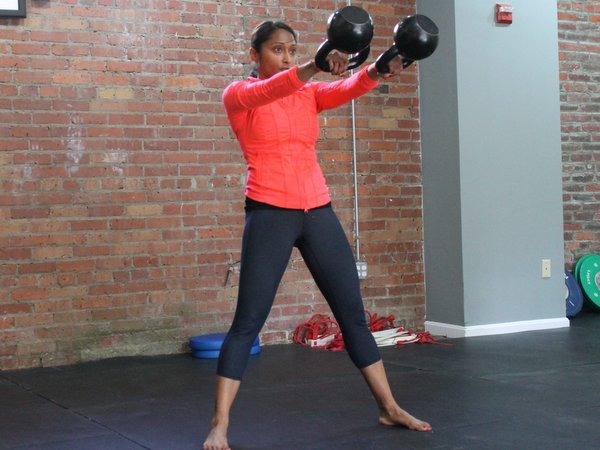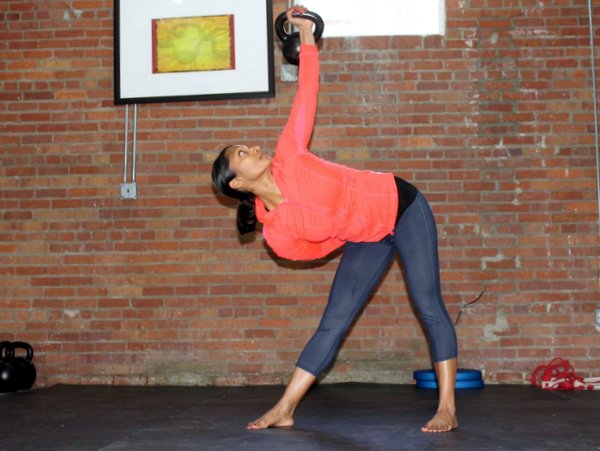http://rkcblog.dragondoor.com/kettlebells-for-sports-performance-training-a-12-week-program/
by REKHA AYALUR on AUGUST 12, 2015


by REKHA AYALUR on AUGUST 12, 2015

Kettlebells in sports performance training and athletic preparation have made a huge impact on athletes of all kinds by combining aerobic and anaerobic conditioning, and strengthening weaknesses such as shoulder strength and mobility. They also improve posterior chain strength, and grip strength. The design of the kettlebell helps teach an athlete to absorb, store, and redirect force in the hips and lower body.
Kettlebells allow athletes to mimic movement patterns used in a sport more accurately. I coach at a sports performance center in Alexandria, Virginia where we regularly see huge athletic gains simply from kettlebell training. In this post you’ll see my perspective on kettlebell usage and how my coaching is slightly different than most instructors since I focus on a triphasic approach to kettlebell programs.
My Early Days as an Athlete
When I picked up my first weight in the early 90s, I’d never heard of kettlebells. I was on the high school track team and remember learning how to do back squats, bench press, and various dumbbell movements at our school’s weight training class. At the “monstrous” size of 5’2’’ and 95 pounds, I was quite strong for my size. I held the school record for lifting the most for my weight and loved lifting heavy—I was the petite, female, Indian version of a “meat head”. At the end of track practice, we had mandatory weight training consisting of bench press, back squats, lat pulls, dumbbell flys, and whatever else our coach thought would make us faster on the track. This was my introduction into the world of weight training.
After high school, I ran cross-country and track at a Division I college. I was running an average of 40-60 miles a week with mandatory weight room training twice a day. Our strength coach also worked with the football team, and I’m pretty sure our strength program was the same as theirs. I never questioned why I was told to back squat 145 pounds or do a 115 pound one-rep max on bench as a distance runner. Surely, the strength coach of a Division I team must know what is best for me to perform better on the track. So as my bench max and squat max continued to climb, my track times continued to get slower. I was angry with myself, frustrated, and depressed. I couldn’t understand why this was happening, I had a Division I training program every day, but I could not perform.
After graduating, I continued to run and lift a lot. I ran a few races here and there, but my times never improved. I eventually got tired of running and focused on other cardiovascular exercises at the gym like elliptical machines and stair climbers. But, I was working out just to work out, with no goals, and no performance gains or improvements in body composition. In fact, my body was breaking down, I needed surgery for a torn hip labrum, my knees were a mess and I felt tired and weak.
My Introduction to Kettlebells
In 2010, while doing a torturous workout on the stair climber, I noticed a small group of people gathered in a corner of the gym using weights I had heard were called “kettlebells”. Later, I asked the instructor if I could join and learn how to use them. At the time I thought kettlebells were just another fad workout craze, but it seemed more interesting than what I had been doing at the gym. I began training with this RKC instructor’s class and quickly became hooked. I became pretty proficient with the major exercises and became stronger using them.

Soon, I wanted to learn everything about this little “bell”. I was in love! My trainer told me that she was coached by another RKC in the area before taking her certification. This was how I began to train with RKC Team Leader, Darius Gilbert at Dynamic Sport Performance (DSP), the facility where I now coach. When I first went to train with Darius, I assumed we would be doing similar RKC-style movements that I had been practicing with my former trainer. I didn’t know that kettlebells could also be used for improving athletic performance. I had only heard that Darius was one of the best RKCs in the area, and I wanted to train with the best. My training sessions quickly turned into an educational on how DSP uses kettlebells to help athletes age eight to adult perform better in their respective sports.
This blog post will provide some insight into what I’ve learned in the last three years about kettlebells and sports performance training.
Kettlebells for Sports Performance Training
One of the main reasons kettlebells help athletes is that kettlebell movements mimic athletic movement patterns. The bell requires athletes to be on their feet where they will develop proprioceptive awareness (awareness of the body in space) and immense grip strength. Every sport requires an athlete to have an awareness of their body—foot placement, shoulder positioning—in order to defend a goal, catch a ball, swing a bat, throw a pass, tackle, swim, explode out of blocks, etc. Sports that require gripping a bat or a ball can also benefit from the grip strength developed from kettlebell training.
Kettlebells also combine anaerobic and aerobic conditioning, which are typically separated in most athletic programs. Our training is high intensity without pounding on the joints like running and jumping, and trains the cardiovascular system without the athlete’s feet ever leaving the ground—this is especially useful for deconditioned athletes. We give our athletes specific movement patterns, such as rotations for baseball which help stability in shoulder girdle. We also use velocity-based training (VBT) to enhance their performance. By applying Cal Dietz’s Triphasic Training approach, we can further utilize kettlebells to help an athlete become more dynamic in their sport.
So, why do kettlebells provide more of an advantage to athletes than conventional barbell lifts? It’s because barbell exercises focus more on the concentric phase of the lift. Usually, the concentric movement gets the most “credit”. The eccentric phase is when the weight is lowered, and an isometric contraction occurs when you reach a complete pause in the lift. Athletes MUST train all three phases to see gains in their performance. Period. No sport uses only concentric movements, so why would you only train that phase of a lift?
Below, I have outlined a typical 12-week kettlebell program with a triphasic approach that we use with our athletes. The first exercise primes the athlete’s nervous system. We utilize un-weighted jumps—vertical and horizontal—to train force displacement. Weighted ballistic lifts train the athlete’s muscles to eccentrically and isometrically absorb energy before applying it in explosive dynamic movements. Each phase is performed for 4 consecutive weeks:
| Lower Body Phase: Phase 1- Eccentric
Phase 2 – Isometric
Phase 3 – Concentric (Pre-season. Preparing for competition, 55% of weight)
All of the exercises below should be reactive. The athlete should drop down as fast as they can, stick the isometric portion, and explode out of the lift.
| Upper Body Phase: Phase 1: Eccentric
Phase 2 – Isometric
Phase 3 – Concentric
|
Results From Our Athletes
This program is given to all of our athletes—from baseball players to track athletes—and the success of this training approach has allowed them to experience immense improvements in overall performance. In addition to using the triphasic approach, we also incorporate velocity-based training into our athlete’s programs. Using the Push Band, we can calculate velocity and track our athlete’s optimal rep and weight range to enhance performance. Velocity is the rate at which an object travels in meters per second (m/s).
At DSP, we use simple kettlebell exercises—swing, snatch, clean—to focus on building strength-speed (strength in conditions of speed), and speed-strength (speed in conditions of strength), both equally important in developing optimal athletic performance.
One of our baseball athletes is Hughes. He’s going into his senior year in high school and began training at DSP about a year ago. When he first came to us, he was running 7.6 for 60m. He recently ran a 7.03 at the baseball combine in California. With velocity-based training, we were able to gauge that Hughes can swing a kettlebell at 4 m/s (optimal velocity for speed training) for four reps. For anything after four reps, the velocity decreases. The same test can be performed with the kettlebell snatch and clean—all result in similar findings, a rep range of between 3-4 produces the optimal velocity for speed training. Given this data, we are able to create a program for Hughes that keeps him in a low rep range, with lower weight, while producing the optimal velocity to enhance his baseball performance—and boy, has it! Hughes recently signed to play baseball with the #1 ranked University of Virginia baseball team!
The last three years have taught me a lot about kettlebells and the incredible benefits they can provide for athletes. While I’m not that girl who was running in college anymore, I still consider myself to be an athlete and will always train like one. If I’d known what I know now about kettlebell training, I would have been a better, stronger athlete. So I take the knowledge I have gained through my own personal journey with kettlebells and provide it to the athletes that I train now, and live vicariously through the successes they achieve through our coaching in their sport.
***
Rekha Ayalur, RKC, and PCC Instructor is a performance coach at Dynamic Sport Performance. She began her athletic career in high school where she was a middle distance runner. and went on to compete at the collegiate level for a Division I program. As a performance coach, Rekha specializes in training athletes ranging in age from 8 years – adult where she utilizes kettlebells in a triphasic approach to building athletic performance.
Комментариев нет:
Отправить комментарий